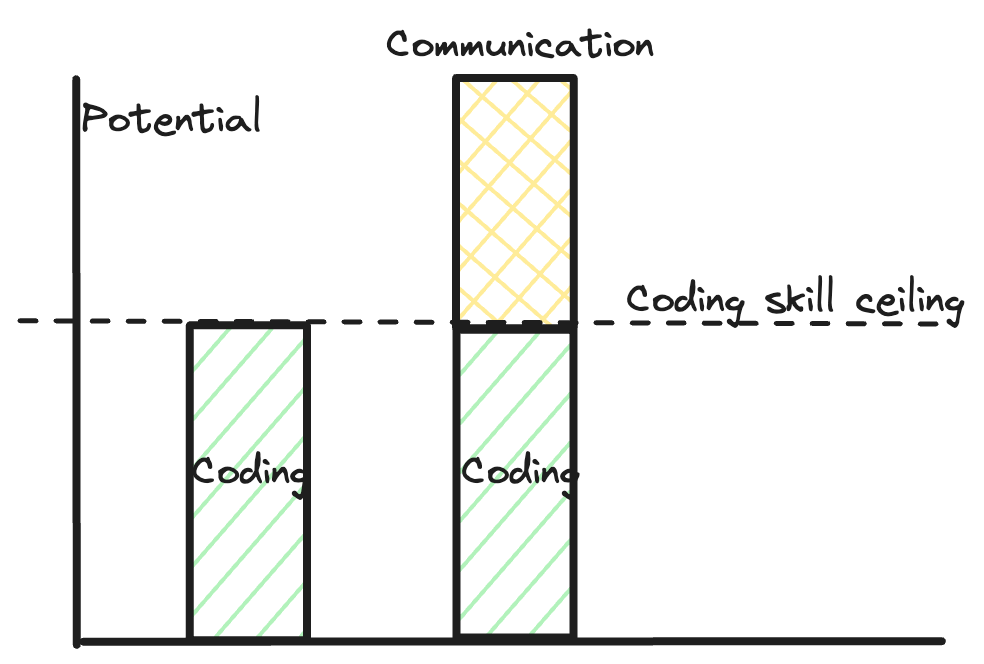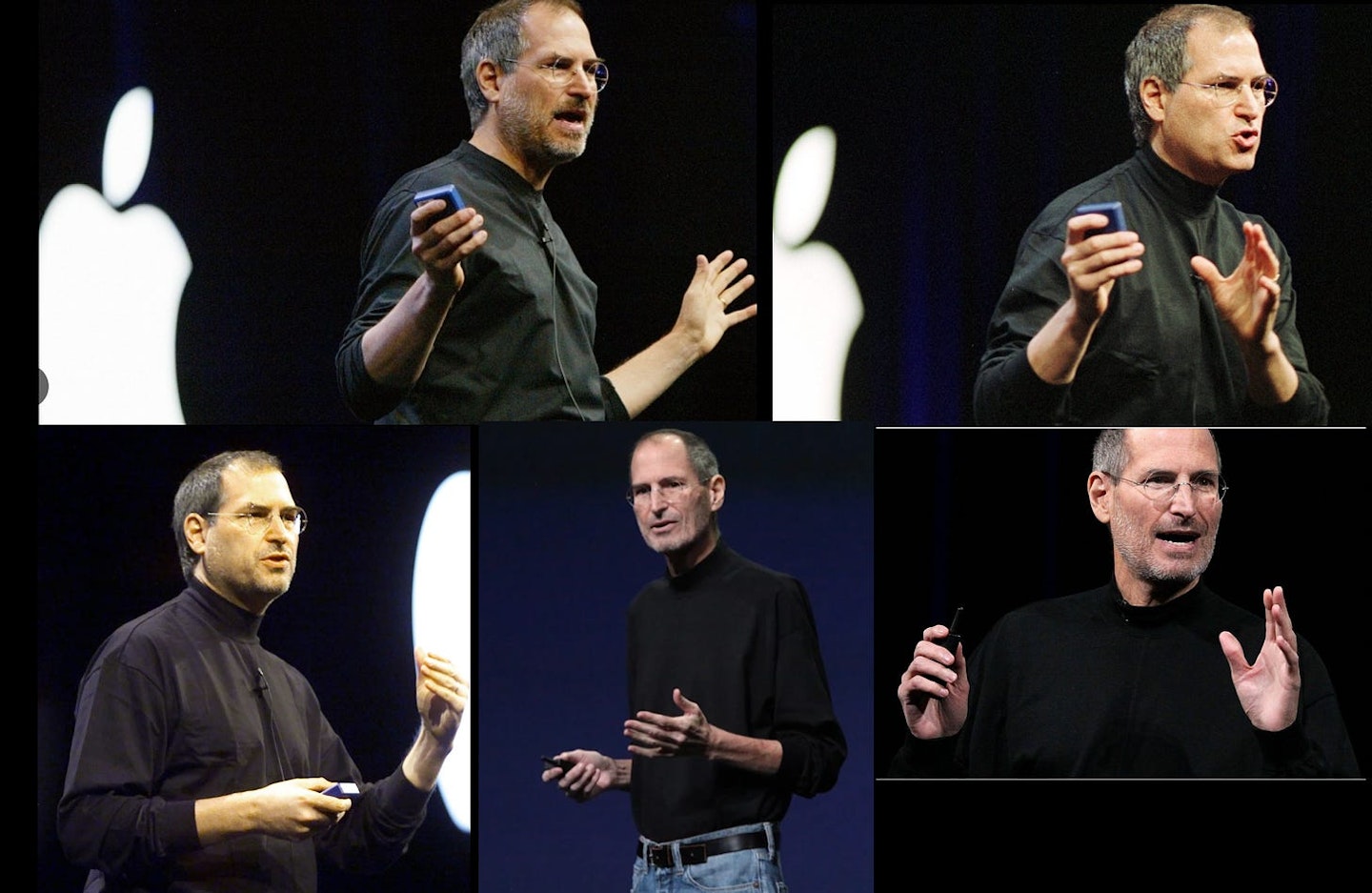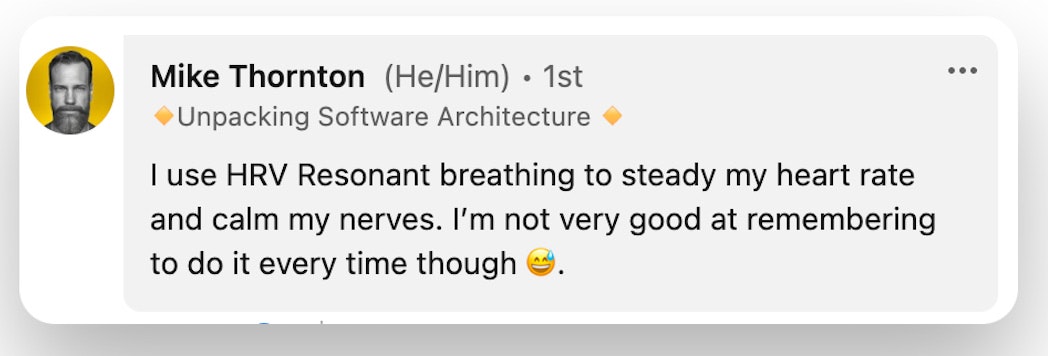“Your technical skills are where they need to be, but you need to improve your communication.” - Your manager. This is one of the hardest pieces of feedback to hear as a software engineer. Why? Because you probably thought as a software engineer you can just speak code. But no. Only focusing on code can lead to a ceiling in your potential for growth and promotions.

Only focusing on coding skills causes you to reach a ceiling. Communication unlocks more potential. Inspired by Caleb Mellas’s post
⭐️ Main takeaways
While there’s a lot to communication, this post is focused on public speaking.
Specifically, we’ll cover:
- The most important areas to fix in your body language, wording, and tonality.
- How to create a presentation structure that keeps people listening to you.
The concepts here can be applied to:
- In-person & remote tech talks, demos, and technical direction presentations
- Leading meetings
- Interviews
Disclaimer: My advice is based on what has worked for me, but there are certainly exceptions. It will not apply to 100% of situations.
👤 Your body language
If you only take one thing from this section: Be open with your body language.
(1) Your eyes
There are 3 patterns you want to avoid:
- Staring at one person in the audience
- Staring at the slides
- Looking down
Instead, slowly rotate your head across the back of the audience and only look at your slides when you intentionally want the audience to look at the slides.
This gives you an aura of confidence and makes your audience feel like you are speaking directly to them, not your slides.
(2) Your posture
As software engineers, we have a tendency to hunch from sitting at the desk all day. To fix this you can try this before your presentation:
- Put your back to a wall, ensuring your shoulders and head are touching the wall.
- Stand up straight, look directly ahead, roll your shoulders back until it feels like you went too far, then let them naturally fall into place.
Having improved posture has these benefits:
- Your confidence will increase. Your nerves will decrease.
- The audience will be more engaged with you.
- Your voice will naturally project more.
(3) Your hands
One of the most difficult pieces to get down is what to do with your arms and hands. The good news is there’s only 1 thing you need to remember: Keep them open. Our most natural tendency due to nervousness is to close them off, interlock, rub them together, put them in our pockets, etc.
They are all closed body language behaviours.
From there, if you avoid closed body language, your only option is to do what you see other great presenters do:
- Calmly wave your arm in an open-palm position as you explain your point. Do what comes naturally though.
- Point with an open palm to something on the slide to focus on.
Still, there will be small things to improve, like ensuring you’re using both hands rather than just 1. But they’ll come with time. For now, just focus on being open.
Here’s a collage of Steve Jobs mid-presentation. In every image, his hands are never pointing down. They are always open.

Examples from Steve Jobs on what you can do with your hands during a talk. If you’re interested in more, check out this communication experts’ top body language mistakes to avoid.
🗣️ Your words
If you only take one thing from this section, it’s to project confidence. To this day, I still get nervous before presentations. I do at least 1 warm-up technique which helps ease my nerves and primes myself for speaking confidently though.
(1) Warm-up techniques for confidence
These are some things I do sometimes you might find helpful.
- Jumping jacks or push-ups. This helped me get my mind off of the nervousness, get blood pumping, and improve my focus.
- A power roar. Find a soundproof area and shout. Yes, I did do this in my old apartment before presentations and it worked for me 😂. It helped release all the tension that I felt in my stomach.
- Lowest effort: Expand your body!!! Before presentations, I’d find my body tightening up, my legs and arms crossing, and turning into a ball. Don’t let your body do this. Your body influences your mind. Expand your body, stretch, spread out, raise your arms above your head, anything. All of it will help you feel more relaxed.
- [Recommended by friends] Breathing exercises. I personally use the other methods more, but it’s all about finding what works for you

Pro tip: Another thing I’d do the day of the presentation is talk to more people. When you exercise without stretching, what happens? You strain yourself.
So if you have a presentation that day, “stretch” by talking to people. If you’ve spent most of the day talking to people, the presentation won’t feel so different. Compare that to if you spent the whole day without talking to anyone, doing a presentation in front of an audience will be a big 0 → 100 jump.
(2) Rhythm
Avoid speaking too quickly, too slowly, or at the same pace permanently. Be dynamic. If you stick to just one pace, you become monotone, which leads to your audience opening Slack, opening their phone, or sleeping 😴.
Should you speak SLOW or FAST?
To do this right, put your emotions into your presentation. Get excited about the parts you genuinely are most excited about. Your audience will feed off that energy.
One other tip is if you notice yourself using fillers like “um” or “uh” a lot—which remove clarity and authority, you can slow down your pace a bit because it could mean your mind isn’t able to keep up with the rate you’re speaking at. You can also try to pause instead of using the filler.
(3) Tone
It’s common for engineers to speak too quietly or mumble. A tip here is to think of top speakers you look up to and how they sound:
- Tony Robbins
- Michelle Obama
- Steve Jobs
You don’t need to be as good as they are, but at least match their volume. You can even have a go-to speech of theirs you watch beforehand to prime yourself.
(4) Practice
This is well-known so I won’t focus on it too much, but practice. For big presentations, you can also record yourself or practice in front of a friend. It helps you with slight wording tweaks and most importantly, your confidence. Before your presentation, if you know you just need to repeat what you did while practicing yesterday, you’ll be much less nervous.
🎞️ Your content
I have a guide on this already, but I’ll provide a summary of the key points here.
(1) Add interactivity
One of the best ways to add interactivity is through “Question slides” or “Thought slides.” Make a slide that gets people to think about the topic before you teach them.
Let’s say your presentation is about how to be a good mentor.
A thought slide might say: “Think about the best mentor you ever had.” As it pops up, you say, “I want you to tell me if my advice today lines up with how they have mentored.”
A question slide might say: “What does good mentorship look like to you? What about bad mentorship?”
Getting them to think about this makes them interested in hearing what you have to say next and if it lines up with what they came up with.
When you’re presenting to a smaller audience (< 30 people), you can hear directly from the audience and increase the amount of times you do this.
Personal example: One way I added interactivity to a presentation was by asking everyone to close their eyes while I played an audio clip. It helped put them in the shoes of the people I wanted them to build more empathy for—customers who were blind and using a screen reader.
(2) Images > words
Go through every slide with words and ask if it can be replaced with an image. It’s true. Not every slide should be an image. In my experience, the best ones have been about 75% images and 25% words.
When you do use words on your slides, follow these rules:
- If it’s bulleted, try to use 3 or 5 bullets. Using 2 or 4 bullets doesn’t read as well.
- Consider making it a slide with just a single, big, centered sentence.
- Your bullets should be 1 line at most, 2 lines only sometimes, and never 3+ lines.
(3) How to structure the content
You might still be wondering how you put all of this together. There are a few popular frameworks you can follow as a software engineer:
- Problem-Agitate-Solution
Problem-Agitate-Solution is great for persuasion. You can use it to convince your team to adopt a new pattern or change a team process.
You start by concisely describing the problem, then “agitate” by talking about multiple pain points within that problem, and finally explain your solution.
Why it works: You jump straight into a problem people want to solve, hook their emotions by agitating, and then release the tension by providing a path forward.

An example of Problem-Agitate-Solution from my friend, Alex, from Taro
- Before-After-Bridge
Before-After-Bridge is great for stories after having made a change—like a tech talk, all-hands presentation, or advocating for a migration. It’s also a popular format in tech conference talks (“How we increased developer productivity by 2x at X”).
You describe the old state of the system (before), explain the current state of the system (after) and all the benefits, and then finally how you got there.
Why it works: Your audience understands why the system was what it was and the problems with it, they quickly understand and are impressed with the current or new state, but are curious how you got there. Afterward, you give them that payoff by explaining how you got from the old to the new.
- Topic-Why it matters-Information-Recap
This framework is best for informative presentations. You say your topic, tell the audience why it matters to them, tell them the information they need to know, then give a recap. See my LinkedIn explainer. I also used it for my presentation on accessibility and inclusivity at Gusto during our all-hands to 200+ people. Do this in combination with the interactive elements above and you’re set up for success.
Why it works: The audience is hooked by why it matters to them, the information is split into digestible sections, and they get a summary of takeaways to walk away with.
📖 TL;DR
Body language: Keep it open
- Eyes: Rotate across the back of the audience. Don’t stare at slides
- Posture: Stand up straight, roll your shoulders back, head held high.
- Hands: Focus on openness and natural movements. Be aware of tics.
Speech: Focus on confidence
- Warm-up: Build confidence through a warm-up by doing light exercise, breathing techniques, a power roar, expanding your body, or talking to people.
- Rhythm: Avoid being too fast, too slow, or the same pace. Keep it dynamic.
- Tone: Think of famous speakers and how they vocalize. Try to mirror them.
Structure and content: Use a framework
- Interactivity: Use question and thought slides to get interaction.
- Images > words: Use visuals as much as possible. 75% visual and 25% word slide is a decent target to shoot for depending on the presentation.
- Structure: Use Problem-Agitate-Solution, Before-After-Bridge, or Topic-Why it matters-Information-Recap to present your content. There are others but these are my personal favorites and have worked well for me.
These techniques can take a while to master, and I certainly don’t have them 100% down either. My hope is that having this article to reference before your next presentation will get you one step closer to having a showstopper presentation.
This article was originally on Jordan Cutler’s newsletter, High Growth Engineer









.png?w=720&auto=compress,format)

